Exclusive Recipes from Let’s Eat France! by François-Régis Gaudry and Friends

From timeless classics to a savoury twist on a sweet favourite, food critic François-Régis Gaudry and his band of cuisiniers share their guilty pleasures – and some nifty hacks too.
These recipes are from Let’s Eat France! by François-Régis Gaudry and Friends. Cover illustration ©Aurore Carric. Excerpts published with permission of Artisan, the publisher. Purchase the book on Amazon below:
THE SUPERB AND RUSTIC PÂTÉ EN CROÛTE
BY YOHAN LASTRE
Yohan Lastre is Pâté en Croûte World Champion and founder of Lastre Sans Apastrophe (Paris 7th).
EQUIPMENT
1 rectangular metal pâté en croûte mould measuring 12 1⁄4 by 3 inches (31 by 8 cm) Or 1 oval metal pâté en croûte mould measuring 8 1⁄4 by 5 inches (21 by 13 cm)
1 instant-read thermometer
FOR THE GELÉE
1 1⁄8 ounces (32 g) gelatin sheets
4 1⁄4 cups (1L) chicken or vegetable broth
1⁄4 cup (60 ml) ruby port
FOR THE FLAKY PASTRY DOUGH
11 tablespoons plus 1 teaspoon (160 g) unsalted butter
1 egg
1 pinch sugar and 1 teaspoon salt
3 tablespoons plus 1 teaspoon (50 g) water
2 1⁄2 cups (250 g) all-purpose flour
FOR THE FILLING
12 ounces (350 g) boneless and skinless chicken breasts
10 1⁄2 ounces (300 g) boneless chicken thighs
12 ounces (350 g) pork belly, trimmed of fat
12 ounces (350 g) pork tenderloin
1 ounce (28 g) fleur de sel sea salt
Freshly ground black pepper (about 15 turns of the pepper mill)
1 pinch quatre épices spice blend
1⁄3 cup (80 ml) white wine
4 1⁄4 ounces (120 g) pistachios
1 tablespoon (14 g) butter, softened, to grease the mould
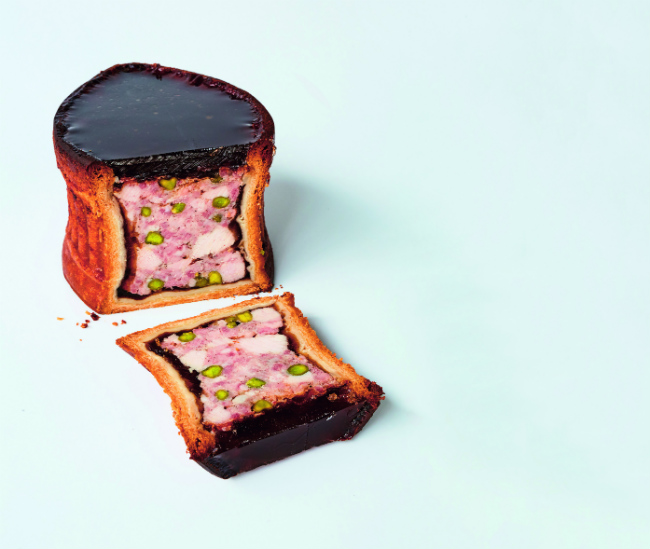
Pâté en croûte. Let’s Eat France. IMAGES © AURORE CARRIC, MARIELLE GAUDRY
Two days before
Make the flaky pastry dough. Melt the butter, let it cool, then pour it into a mixing bowl. Add the remaining ingredients. Beat for 20 seconds, pour it out onto a work surface, and knead it with your hands just until a dough forms. Wrap the dough in plastic wrap and place it in the refrigerator. Make the filling. Cut all the meat into 1 inch (3 cm) pieces. Process the pork belly and chicken thighs through a meat grinder fitted with a grinding plate with large holes. Combine the meat with the remaining filling ingredients, wrap the mixture in plastic wrap, and place it in the refrigerator.
The day before
Grease the mould with the butter. Roll out the dough to a thickness of about 1⁄8 to 1⁄4 in (4 to 5 mm), then line the mould with the dough, going all the way up the sides. Scrape the filling into the mould (do not fold the dough over the top). Preheat the oven to 400°F (200°C). Bake the pâté for about 25 minutes, or until beautifully golden brown, then lower the oven temperature to 275°F (140°C) and bake until the centre reaches 149°F (65°C) on the instant-read thermometer. Meanwhile, make the gelée. Melt the gelatin in the warm broth, then stir in the port. Remove the pâté from the oven and fill it with the warm gélee. Repeat this step four or five times in about 30-minute intervals. Refrigerate the pâté and any remaining gelée overnight.
The next day
Heat the remaining gelée and pour it over the top of the pâté. Place the pâté back in the refrigerator until the gelée has set. To unmould the pâté en croûte, gently warm the mould in the oven to loosen the pâté crust from the pan. Slice and serve.
Chef’s tip: For a pâté that is stronger in flavour, add 2 tablespoons (30 ml) of brandy.
The Crust
The pâté is made with a base of veal and pork enriched with poultry or wild game and wrapped in a pâte brisée (flaky pastry) or a pâte feuilletée (puff pastry). The dough was
first used only for cooking and preserving the meat it encased. It was not until the Middle Ages that the crust was made for eating. In the Viandier, the bible of Medieval cuisine, Charles V’s cook, Guillaume Tirel, also known as Taillevent, developed no fewer than 25 recipes for meat pâtés.
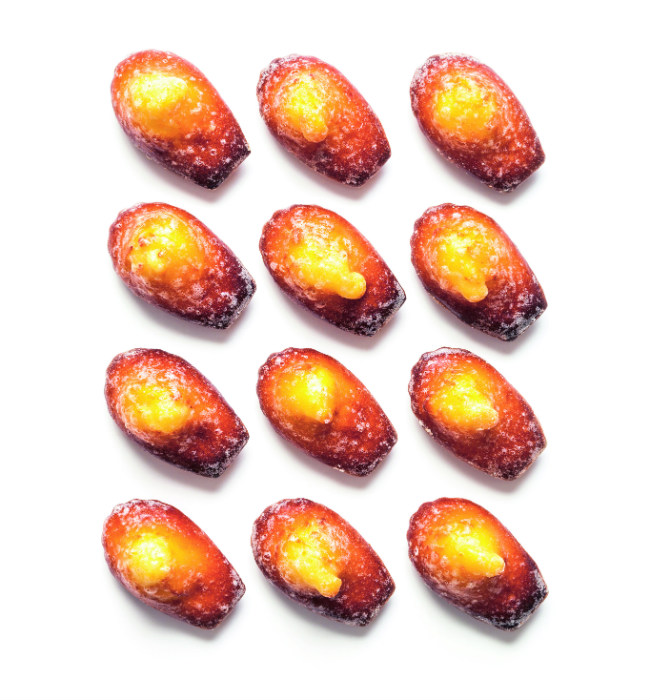
Madeleines. Let’s Eat France. IMAGES © AURORE CARRIC, MARIELLE GAUDRY
MADELEINE BY FABRICE LE BOURDAT
Fabrice Le Bourdat is baker-pastry chef at Blé sucré (Paris 12th).
Resting time: 2 to 3 hours | Baking time: 9 to 10 minutes | Makes 12 madeleines
This sweet madeleine by the chef of the Blé sucré bakery was at the top of the list of the 15 best Parisian madeleines in Figaroscope in 2014. It is perfection. And a little crackly icing makes it even more indulgent.
EQUIPMENT
1 metal 12-hole madeleine mould
INGREDIENTS
2 eggs
1⁄2 cup (100 g) granulated sugar
2 tablespoons plus 2 teaspoons (40 g) milk
1 1⁄4 cups (125 g) all-purpose flour, sifted, plus more for dusting
1⁄8 ounce (5 g) baking powder
9 tablespoons plus 2 teaspoons (140 g) unsalted butter, melted and kept warm, plus more at room temperature for greasing the mould
THE ICING
1 cup plus 3 tablespoons plus 1 teaspoon (120 g) confectioners’ sugar
2 tablespoons (30 g) orange juice
Whisk together the eggs and granulated sugar. Whisk in the milk. Sift the flour with the baking powder. Using the whisk, stir in the flour, then stir in the warm melted butter until thoroughly combined. Let the batter rest in the refrigerator for 2 to 3 hours. Grease the mould with butter, then dust with flour, tapping out any excess. Fill each cavity with the batter and bake for 9 to 10 minutes at 400°F (210°C).
For the icing, stir together the confectioners’ sugar and orange juice. Using a pastry brush, coat the madeleines with the icing.
Faux Pas: Adding honey, vanilla, lemon zest or juice.
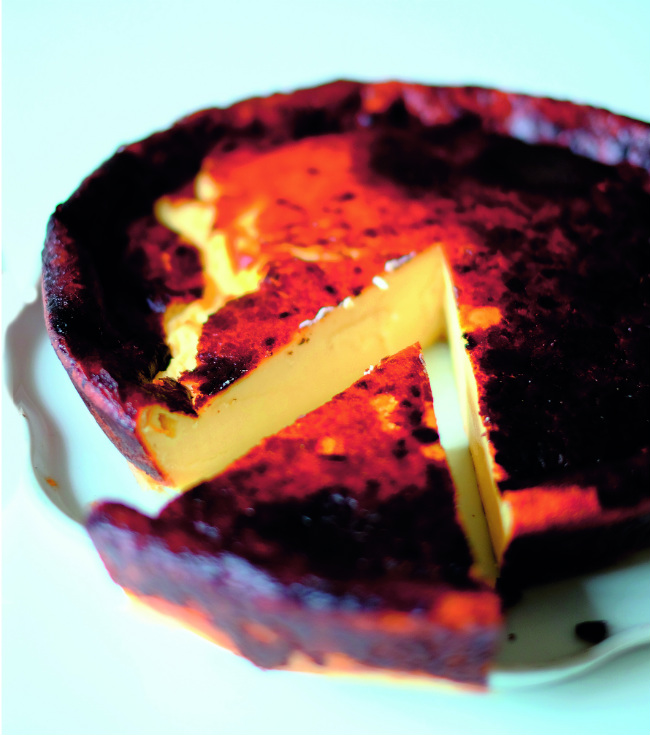
Far Breton Cake. Let’s Eat France. IMAGES © AURORE CARRIC, MARIELLE GAUDRY
PEASANT’S FAR BY THIERRY BRETON
Thierry Breton is the chef at Chez Michel, Chez Casimir and La Pointe du Grouin (Paris 10th)
Preparation time: 10 minutes | Cooking time: 50 minutes | Serves 4
INGREDIENTS
2 1⁄4 cups (220 g) all-purpose wheat flour
3⁄4 cup plus 2 tablespoons (175 g) super fine sugar
1 teaspoon (6 g) sel de Guérande sea salt
5 eggs
4 1⁄4 cups (1L) whole milk
1 cup plus 1 tablespoon (250 g) heavy cream
1 tablespoon plus 2 teaspoons (25 g) butter, for greasing the pan
Flour, for flouring the pan
Preheat the oven to 475°F (250°C). In a large bowl, combine the our, sugar, salt, eggs, milk, and cream. Grease and flour a cake pan with sides; scrape the batter into the pan. Bake for 20 minutes, turn the oven off, then let rest in the oven for another 30 minutes. Let cool before serving.
The Privateer’s (with prunes)
Add 1 tablespoon (15 ml) rum and 1 vanilla bean (split and its seeds scraped into the batter) to the batter. Place 35 soft prunes (with the pits) on the bottom of the pan before scraping in the batter.
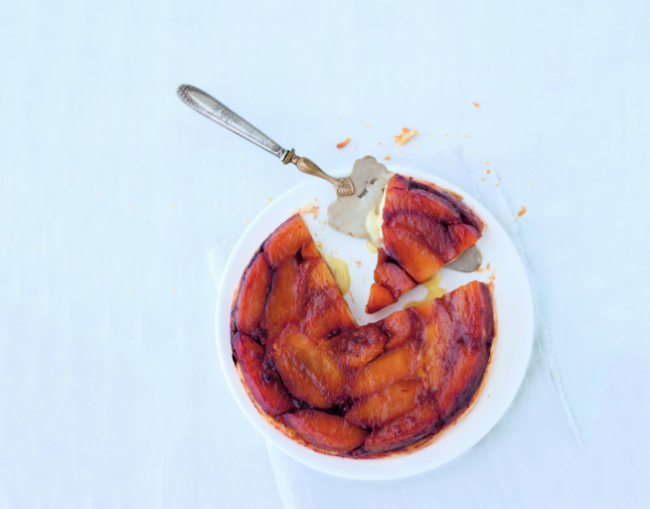
Apple Camembert Tatin. Let’s Eat France. IMAGES © AURORE CARRIC, MARIELLE GAUDRY
APPLE-CAMEMBERT TATIN
Serves 6
INGREDIENTS
4 apples
2 tablespoons plus 2 teaspoons (40 g) unsalted butter
1 tablespoon demerara sugar
1 wheel (9 ounces / 250 g) Camembert cheese, sliced
14 ounces (400 g) puff pastry dough
Preheat the oven to 350°F (180°C). Peel the apples and cut them into thick slices, then lightly sauté them in the butter and sugar. Arrange parchment paper in the bottom of a cake pan or a baking dish. Spread the apples over the top of the parchment, then distribute the slices of Camembert on top. Roll out the puff pastry dough and cover the top of the pan with it, tucking the edges into the pan to make a border. Bake for 20 minutes, or until golden. Serve warm with a green salad and a dry craft cider.
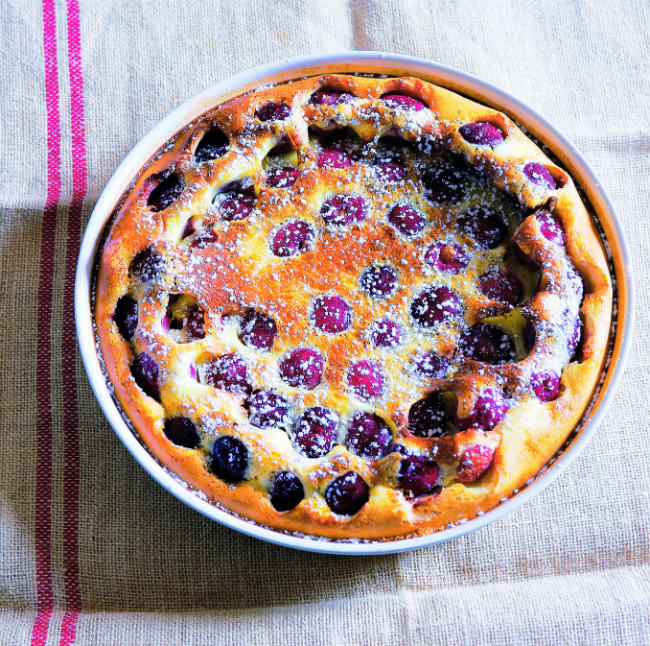
Classic Clafoutis. Let’s Eat France. IMAGES © AURORE CARRIC, MARIELLE GAUDRY
CLASSIC CLAFOUTIS
Serves 8
INGREDIENTS
1⁄2 vanilla bean
2 1⁄2 cups (250 g) all-purpose flour
5 eggs
4 tablespoons (50 g) granulated sugar
1 pinch salt
2 1⁄8 cups (1⁄2L) milk
Butter, for greasing the baking dish
1 1⁄8 pounds (500 g) ripe cherries, with pits
Confectioners’ sugar (optional)
Split the vanilla bean lengthwise in half and scrape out and save the seeds. Whisk together the flour, eggs, granulated sugar, salt, and vanilla bean seeds. Gradually whisk in the milk, until the mixture forms a smooth batter. Grease a baking dish with butter. Arrange the cherries (do not pit them) in the bottom of the dish. Pour the batter over the cherries. Bake at 400°F (200°C) for about 30 minutes, or until golden. Carefully lift the clafoutis out of the baking dish and onto a serving platter. Dust with confectioners’ sugar, if desired.
CRUMBLE CLAFOUTIS BY PHILIPPE CONTICINI
Serves 8
FOR THE CRUMBLE TOPPING
5 tablespoons (70 g) unsalted butter, softened 2 1⁄4 tablespoons (30 g) brown sugar
3 1⁄2 ounces (100 g) speculaas cookies, crushed
FOR THE BATTER
3 vanilla beans
3 eggs
1⁄2 cup (70 g) hazelnut flour
2⁄3 cup plus 1⁄2 teaspoon (135 g) demerara sugar, plus more for sprinkling
1⁄2 cup plus 2 1⁄2 teaspoons (55 g) all-purpose flour
1⁄2 teaspoon (3 g) fleur de sel sea salt
1 teaspoon (2 g) ground cinnamon
1 ounce (25 g) crème fraîche
1⁄2 cup plus 1 tablespoon plus 1 1⁄2 teaspoons (140 ml) low-fat milk
Zest of 1 organic orange
2 tablespoons (30 ml) crème de cerises cherry liqueur (optional)
1 tablespoon (15 g) butter, for greasing the dish
1 1⁄8 pounds (500 g) cherries
Preheat the oven to 325°F (160°C). Make the crumble topping. Combine the butter, brown sugar, and cookies in a bowl. Spread the topping onto a baking sheet and bake for 15 to 20 minutes, or until golden. Increase the oven temperature to 350°F (180°C). Make the batter. Split the vanilla beans lengthwise and scrape out and save the seeds. Using an electric mixer, beat the eggs until foamy. Add all the dry ingredients, and beat until combined. Add the crème fraîche, milk, zest, and crème de cerises, if using. Beat for about 30 seconds until smooth. Let stand for 15 minutes. Grease a cake pan with the butter and arrange the cherries in the bottom of the pan, then scrape the batter into the pan. Cover the top with the crumble, then sprinkle with demerara sugar. Bake for 30 to 40 minutes, or until golden.
As seen in France Today magazine

Author Francois-Regis Gaudry. Photo credit: Marielle Gaudry
Share to: Facebook Twitter LinkedIn Email
Leave a reply
Your email address will not be published. Required fields are marked *



